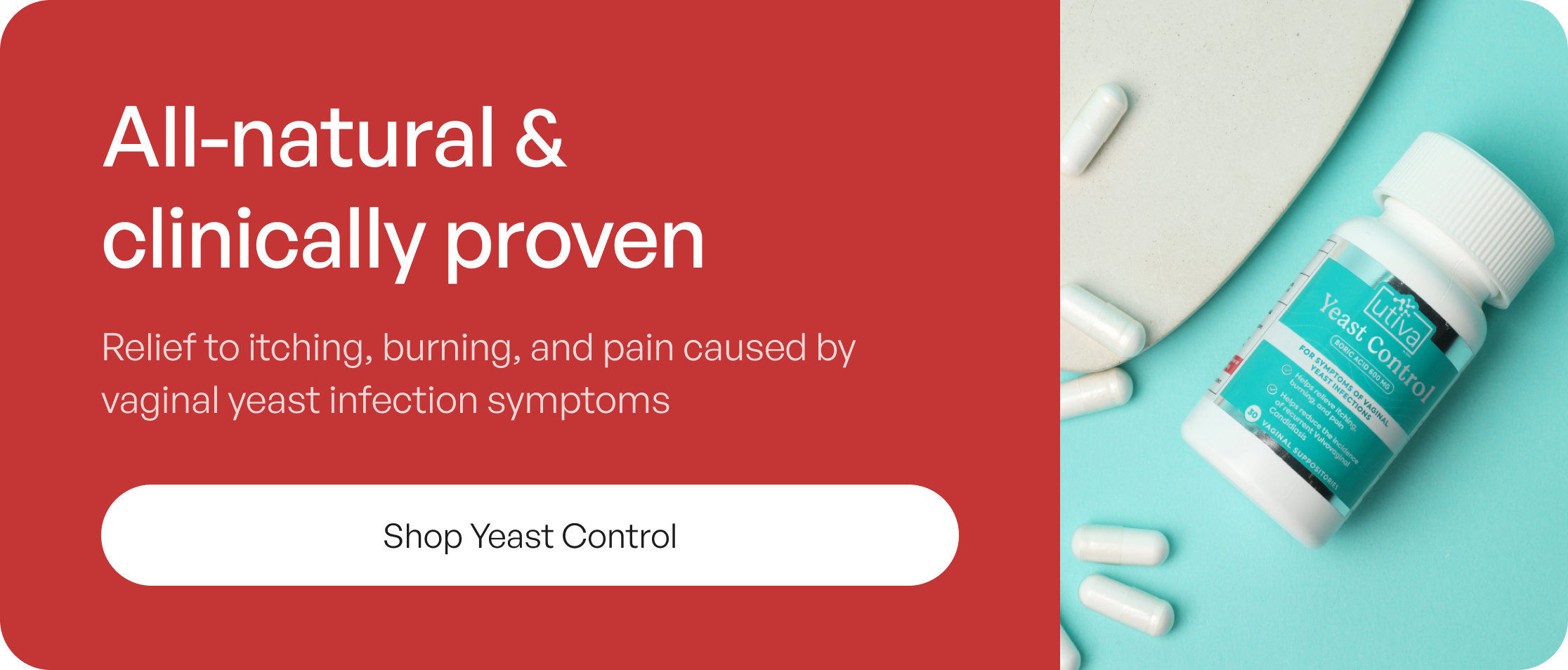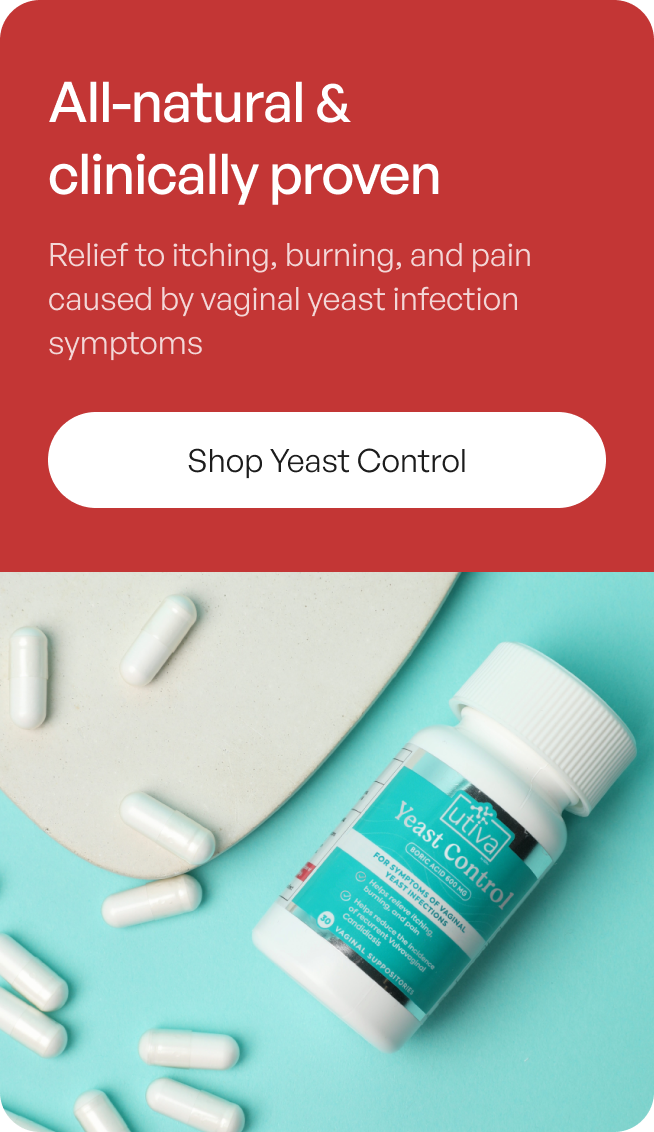Vaginal pH 101: A Balancing Act

Your vagina is amazing. It’s an entire ecosystem with over 500 types of bacteria, all working together to keep you healthy. Your vagina is also designed to clean itself and balance its own acidity—also known as the pH.
But what happens if your vaginal pH balance is off? It can increase your risk of developing yeast infections, bacterial vaginosis (BV), and infertility. Let’s explore how the vaginal pH works, what can throw it off balance, and how natural yeast infection solutions like a boric acid suppository can treat symptoms and restore the pH peace.
What is your vaginal pH?
pH is a measure of how acidic or basic (AKA alkaline) something is. The more balanced your vaginal acidity is, the better it is at stopping harmful bacteria from multiplying. That’s why your vaginal pH is a great way to tell how healthy your vagina is overall.
What is a normal pH range for a healthy vagina?
A vaginal pH level is usually between 3.8 and 4.5. But the definition of a “normal” pH level depends on a lot of factors, including your age, menstrual cycle, and the stage of life you’re in. For example, after menopause, a healthy pH value is usually 4.5 or higher.
Overall, the goal is to have a more acidic vaginal pH. A neutral or alkaline pH is the perfect environment for bacteria and yeast to multiply, leading to conditions like vaginitis. The less acidic your vaginal pH is, the more at risk you are for infection.

How does the vagina maintain pH balance?
Your vagina is really good at regulating its own pH. The vaginal cells produce glycogen, which the bacteria then uses to produce lactic acid. This keeps the environment acidic and stops harmful bacteria from taking over.
It’s like a well-oiled acid machine. But sometimes, external factors can interfere with the process.
What causes an imbalance in the vaginal pH?
Anything that comes into contact with the vagina can impact the pH—from period blood to sex toys. Here are some of the most common pH disruptors:
- Menstruation. Period blood is slightly alkaline, so it can increase the pH when it flows through the vagina.
- Sex. Vaginal penetration, with or without a condom, can affect your vaginal pH. That includes fingering or sex toys.
- Hygiene products. Scented sprays, douching, and steaming can all alter the balance of bacteria in the vagina.
- Antibiotics. Since antibiotics wipe out all bacteria, good and bad, it can kill off the bacteria needed to maintain a healthy pH.
If your vaginal pH is constantly out of whack, talk to your doctor about lifestyle changes you can make to protect your bacteria balance.
What are the signs of vaginal pH imbalance?
One of the first signs of an unbalanced vaginal pH is odour. You might notice a fishy or unpleasant smell, even after a few showers. But that’s not the only alarm bell to watch for.
Other common signs of a vaginal pH imbalance include:
- Changes in colour or texture of your vaginal discharge (thick and white like yeast infection discharge or watery gray/green like BV discharge)
- Itchy vagina
- Pain during or after sex
- Pain or burning when you pee
If you notice any of the above symptoms, you might have a vaginal infection caused by a pH imbalance.
What can happen if your vaginal pH is unbalanced?
Your vaginal pH is there to protect you. But if the balance is off, bad bacteria can take over and cause frustrating conditions like bacterial vaginosis (BV) and yeast infections.
BV is the most common vaginal condition in women aged 15-44. Although BV is easily treatable, it could increase your risk of developing more serious infections like chlamydia, gonorrhea, or HIV.
Yeast infections are also extremely common for women. Up to 75% of people with a vagina will experience a yeast infection at some point in their life—and the itchiness and discomfort that come along with them.
Not sure which problem your symptoms point to? Read this blog to understand the differences between the most common vaginal conditions.
Apart from infections, an unbalanced vaginal pH can also lead to infertility. Sperm thrive in alkaline environments—anything higher than a 7 on the pH scale. During ovulation, the cervical mucus becomes more alkaline so that sperm have a chance to survive. If your vagina is too acidic, sperm are less likely to reach the egg and fertilize it.
How can you get your vaginal pH back in balance?
Sometimes, simple lifestyle changes can help restore your vaginal pH and support healthy bacteria. Things like drinking more water and improving your hygiene. But if you think BV or a yeast infection is brewing, you might need to take a more targeted approach.
Over-the-counter treatments can help ease symptoms quickly, like antifungal creams or vaginal suppositories. More serious cases might require antibiotics or prescription medication. As always, talk to your doctor about your symptoms and decide together what the best course of action is.
How can you maintain a healthy vaginal pH?
So, you’ve successfully brought your pH back into balance. Now how do you keep it that way?
There are so many changes you can make to keep bacteria levels happy and healthy, such as:
- Washing your vulva gently and regularly.
- Avoiding douches or other internal cleansers. Remember: your vagina is self-cleaning—she’s an independent woman.
- Removing damp underwear or swimsuit bottoms as soon as possible so bacteria doesn’t have time to grow.
- Wearing looser-fitting bottoms and cotton underwear so your vagina can breathe.
- Wiping from front to back to prevent intestinal bacteria from spreading to your uterus.
- Taking a high-quality probiotic with Lactobacillus strains.
- Practicing safer sex to reduce the risk of STI and bacteria spread.
- Taking a boric acid suppository to balance your vaginal pH and relieve symptoms of yeast infection.
What is the best boric acid suppository to balance vaginal pH?
The best boric acid for vaginal health is one that contains at least 600mg of boric acid and targets multiple infection-causing strains at once. Enter: Utiva Yeast Control.
This natural yeast infection solution gently balances the vaginal pH to provide quick relief for all the worst yeast infection symptoms—itching, burning, pain, discomfort.
How does it work? By targeting all the common bacteria that causes vaginal infections, like Candida albicans and Candida glabrata, plus all the pesky bacteria that are resistant to antifungal medication.
Simply insert the boric acid suppository into the vagina (with your finger or a suppository applicator) and the clinically-proven formula will start working its magic.
Developed by leading experts in women’s health, Utiva Yeast Control is an effective boric acid for yeast infection—and a healthy, happy, balanced pH.
References:
- https://www.cdc.gov/std/bv/stats.htm
- https://www.healthline.com/health/womens-health/vaginal-ph-balance#risks
- https://sciencedirect.com/science/article/pii/S2452231718300277#:~:text=Overall%2C%20the%20581%20bacteria%20identified,2a).
- https://www.ncbi.nlm.nih.gov/books/NBK459216/
- https://www.sciencedirect.com/science/article/abs/pii/S0140673607609179
- https://www.ncbi.nlm.nih.gov/pmc/articles/PMC8083857/
- https://www.summerseve.com/blog/what-feminine-ph-balance-and-why-should-i-care
- https://www.vierafertility.com/blog/why-ph-regulation-is-so-important-for-a-healthy-pregnancy/
Knowledge is power
Sign up to our newsletter to keep learning!

- Choosing a selection results in a full page refresh.
- Opens in a new window.








